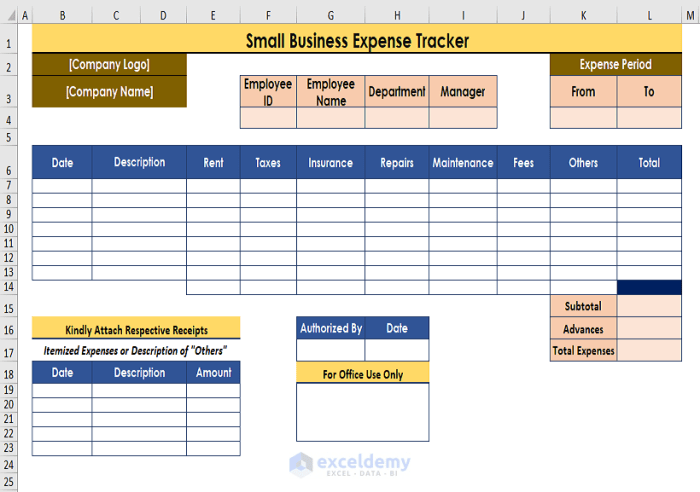Get ready to dive into the world of tracking expenses, where financial savvy meets practical know-how. With a touch of american high school hip style, this guide will take you on a journey to mastering the art of budgeting and saving money with flair.
As we explore the methods, benefits, and importance of tracking expenses, you’ll uncover the secrets to financial success and empowering your wallet.
Importance of Tracking Expenses
![]()
Tracking expenses is like having a financial GPS to navigate through your money matters. It helps you stay on top of your spending habits, make informed decisions, and reach your financial goals. Let’s dive into why it’s crucial to keep a close eye on your expenses.
Benefits of Tracking Expenses
- Provides a Clear Picture: By tracking your expenses, you get a clear view of where your money is going. This awareness can help you identify areas where you can cut back and save more.
- Helps in Budgeting: When you know exactly how much you’re spending, you can create a realistic budget. Tracking expenses allows you to allocate funds to different categories effectively.
- Aids in Saving Money: Monitoring your expenses can help you see patterns in your spending behavior. You can pinpoint unnecessary purchases and find ways to save more for future goals.
Methods of Expense Tracking
Tracking expenses is essential for managing your finances effectively. There are various methods you can use to track your expenses, each with its own advantages and disadvantages. Categorizing expenses is also crucial for gaining insights into your spending habits and making informed financial decisions.
Using Apps
- Advantages:
- Convenient and user-friendly interface for inputting expenses on-the-go.
- Automatically categorizes expenses for easy tracking and analysis.
- Provides insights through visual representations like charts and graphs.
- Disadvantages:
- May require a subscription fee for advanced features or ad-free experience.
- Potential privacy concerns with linking bank accounts for automatic expense tracking.
- Dependent on internet connection for real-time updates and synchronization.
Using Spreadsheets
- Advantages:
- Customizable to fit your specific tracking needs and preferences.
- No subscription fees or privacy risks associated with third-party apps.
- Accessible offline and easily shareable with others for collaborative budgeting.
- Disadvantages:
- Manual data entry can be time-consuming and prone to errors.
- Lacks automated categorization and visual representations for quick insights.
- Requires basic spreadsheet skills to set up and maintain effectively.
Using Specialized Software
- Advantages:
- Offers advanced features like receipt scanning and expense report generation.
- Integrates with other financial tools for a comprehensive view of your finances.
- Automates repetitive tasks like expense categorization and budget tracking.
- Disadvantages:
- Costly upfront investment compared to free or basic tracking methods.
- Learning curve to master all the features and functionalities of the software.
- Dependent on software updates and customer support for ongoing usability.
Creating a Budget
Creating a budget is a crucial step in managing your finances effectively. By tracking your expenses, you gain insights into where your money is going, which is essential for creating a realistic budget that aligns with your financial goals.
Steps to Create a Personalized Budget
- Calculate Your Income: Start by determining your total monthly income after taxes.
- Track Your Expenses: Use the data from your expense tracking to categorize your spending habits.
- Identify Fixed and Variable Expenses: Differentiate between fixed expenses (rent, utilities) and variable expenses (entertainment, dining out).
- Set Financial Goals: Determine short-term and long-term financial goals to prioritize your spending.
- Create a Budget: Allocate your income to cover essential expenses first, then allocate funds for savings and discretionary spending.
- Review and Adjust: Regularly review your budget to ensure you’re on track with your financial goals and make adjustments as needed.
Significance of Setting Financial Goals within Budgeting Process
Setting financial goals within your budget helps you stay focused and motivated to achieve them. By aligning your spending with your goals, you are more likely to make informed decisions about your finances and prioritize what truly matters to you.
Analyzing Spending Patterns
Tracking expenses is not just about recording your purchases; it’s also about understanding your spending habits to make informed financial decisions. Analyzing your spending patterns can help you identify where your money is going, how much you are spending on different categories, and where you can make adjustments to save more or spend wisely.
Tips for Analyzing Spending Habits
- Review your expenses regularly: Take a look at your expenses weekly or monthly to see where your money is going.
- Categorize your expenses: Group your expenses into categories like groceries, utilities, entertainment, etc., to see which areas you are spending the most.
- Identify trends: Look for patterns in your spending, such as seasonal spikes or recurring expenses, to better understand your habits.
- Set spending goals: Determine how much you want to allocate to each category and compare it to your actual expenses to see if you need to adjust your budget.
Role of Tracking Expenses in Financial Decision-making
By analyzing your spending patterns, you can make more informed financial decisions, such as cutting down on unnecessary expenses, saving for future goals, or investing in areas that matter to you.
- Track your progress: Monitoring your spending patterns over time can help you see if you are moving closer to your financial goals or if you need to make changes.
- Spot areas for improvement: Identifying spending patterns can highlight areas where you can cut back or reallocate funds to meet your financial objectives.
- Build better habits: Understanding your spending habits can help you develop better money management skills and create a more sustainable budget.

